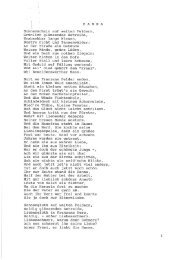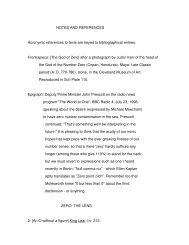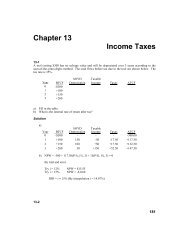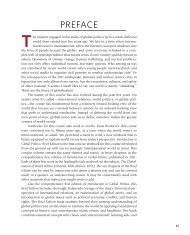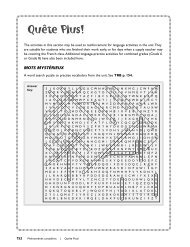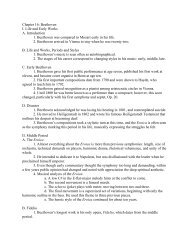CHAPTER 3 Consumer Preferences and Choice
CHAPTER 3 Consumer Preferences and Choice
CHAPTER 3 Consumer Preferences and Choice
Create successful ePaper yourself
Turn your PDF publications into a flip-book with our unique Google optimized e-Paper software.
03-Salvatore-Chap03.qxd 08-08-2008 12:41 PM Page 73<br />
✓ Concept Check<br />
What happens to the<br />
budget line if the price<br />
of Y falls more than the<br />
price of X?<br />
Q Y<br />
20<br />
15<br />
10<br />
0<br />
J"<br />
J 9<br />
J<br />
K<br />
K9<br />
5 7.5 10<br />
K"<br />
Q X<br />
Q Y<br />
10<br />
J<br />
<strong>CHAPTER</strong> 3 <strong>Consumer</strong> <strong>Preferences</strong> <strong>and</strong> <strong>Choice</strong> 73<br />
If only the price of good X changes, the vertical or Y-intercept remains unchanged,<br />
<strong>and</strong> the budget line rotates upward or counterclockwise if PX falls <strong>and</strong> downward or<br />
clockwise if PX rises. For example, the right panel of Figure 3.7 shows budget line JK (the<br />
same as in Figure 3.6 at PX = $2), budget line JK ′′ with PX = $1, <strong>and</strong> budget line JN ′ with<br />
PX = $0.50. The vertical intercept (endpoint J) remains the same because I <strong>and</strong> PY do not<br />
change. The slope of budget line JK ′′ is −PX /PY = −$1=$1 =−1. The slope of budget<br />
line JN ′ is −1/2. With an increase in PX, the budget line rotates clockwise <strong>and</strong> becomes<br />
steeper.<br />
On the other h<strong>and</strong>, if only the price of Y changes, the horizontal or X-intercept will<br />
be the same, but the budget line will rotate upward if PY falls <strong>and</strong> downward if PY rises.<br />
For example, with I = $10, PX = $2, <strong>and</strong> PY = $0.50 (rather than PY = $1), the new vertical<br />
or Y-intercept is QY = 20 <strong>and</strong> the slope of the new budget line is −PX /PY = −4.<br />
With PY = $2, the new Y-intercept is QY = 5 <strong>and</strong> −PX=PY = −1 (you should be able to<br />
sketch these lines). Finally, with a proportionate reduction in PX <strong>and</strong> PY <strong>and</strong> constant I,<br />
there will be a parallel upward shift in the budget line; with a proportionate increase in<br />
PX <strong>and</strong> PY <strong>and</strong> constant I, there will be a parallel downward shift in the budget line.<br />
Example 3–4 shows that time, instead of the consumer’s income, can be a constraint.<br />
0<br />
K<br />
K"<br />
N9<br />
5 10 20 Q X<br />
FIGURE 3.7 Changes in the Budget Line The left panel shows budget line JK (the same as in Figure 3.6<br />
with I = $10), higher budget lineJ ′ K ′ with I = $15, <strong>and</strong> still higher budget line J ′′ K ′′ with I = $20 per day. PX <strong>and</strong><br />
PY do not change, so the three budget lines are parallel <strong>and</strong> their slopes are equal. The right panel shows budget<br />
line JK with PX = $2, budget line JK ′′ with PX = $1, <strong>and</strong> budget line JN ′′ with PX = $0.50. The vertical or<br />
Y-intercept (endpoint J) remains the same because income <strong>and</strong> PY do not change. The slope of budget line JK ′′<br />
is −PX /PY =−$1/$1 =−1, while the slope of budget line JN ′ is −1/2.



